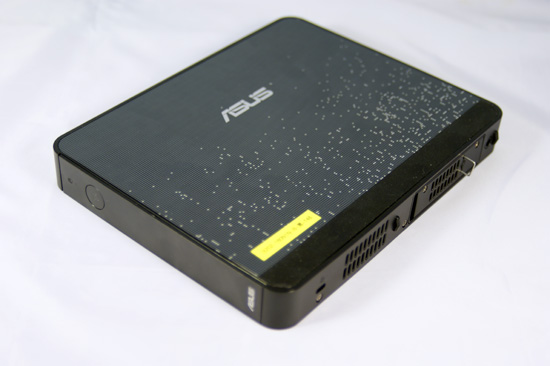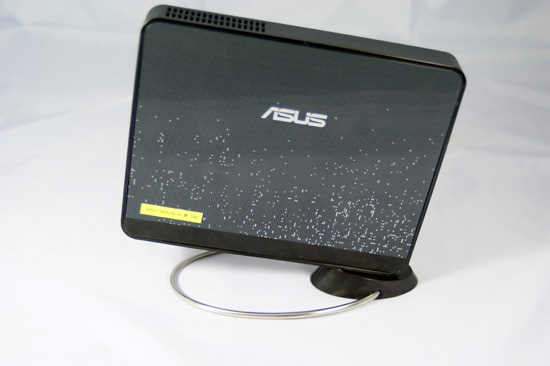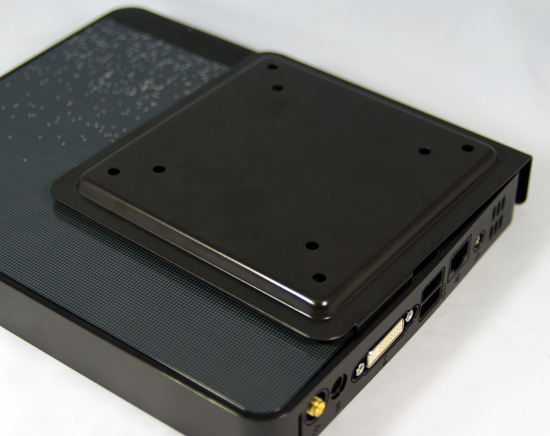ASUS Eee Box Preview & Intel's Atom Benchmarked
by Anand Lal Shimpi on June 3, 2008 12:00 AM EST- Posted in
- Systems
It’s My Eee in a Box
The Eee Box comes in an extremely sleek form factor; it’s thinner than a Mac mini but has a larger footprint, making it more like an Apple TV or other net appliance despite it being a full PC.
There are three mounting options for the Eee Box:

Flat on a table

Vertically on its stand

Behind your monitor using the supplied VESA mount
The front of the Eee Box continues the sleek design by covering the power button and front ports with a flip down panel. Unfortunately you can’t actually turn the unit on without flipping down the panel first, so it’s purely an aesthetic thing designed to simplify the front.

With the front panel flipped down you’ve got a HDD activity LED, power button/LED, two USB ports, a SD card slot, 1/8” audio out and 1/8” mic input. Connecting to any of these ports unfortunately does ruin the look of the device but it is obviously nice to have them there for occasional use.

The back of the Eee Box is far less concealed; you’ve got a single 1/8” audio output, 10/100/1000 Ethernet, two more USB ports, DVI out, DC power in and RF in for an external antenna. The Eee Box also supports Bluetooth for a nearly wireless setup. There is no HDMI output nor any way to get digital audio out, but we’ll touch on the implications of that later.

The right side of the machine has a removable drive tray for the single 2.5” SATA drive that ships with the machine.
Inside the Eee Box
Before even starting the review we dissected the Eee Box to get a glimpse at the first "desktop" implementation of Intel's Atom processor, the full gallery is here:
We've seen the Atom processor in the wild a number of times already, but to put it in perspective here it is compared to a standard LGA-775 Core 2 processor:

At the top we have the Intel 945GMCH, the sliver of a CPU in the middle is the Atom, to the left of it is a standard Core 2 Duo E7200 and to the right is the 802.11n card. Above the 802.11n card is the sole SATA/power ports on the motherboard.
















35 Comments
View All Comments
Casper42 - Tuesday, June 3, 2008 - link
Gigabit Network with 2 USB Ports means you could make a sidecar that holds a small Power supply and 2 Desktop Drives (1TB Each) and plug them in USB.That gives you a SATA Boot drive and then either 2TB in RAID0/JBOD or 1TB in RAID1
Small enough to not run up your power bill like crazy and yyet still flexible enough to run your OS of choice for the hosting platform and any other little utilities you might want (cough BT Client cough).
erikstarcher - Tuesday, June 3, 2008 - link
Looks like it would make a great car pc. hook up a 7" touchscreen to it for control and you are set. I bet it would do music, video (non hd) and gps without a problem. And it won't kill your battery as fast as some other solutions (like the laptop I am now using).Yooshaw - Tuesday, June 3, 2008 - link
This was my first thought - you could really make a killer Carputer with this thing.strikeback03 - Wednesday, June 4, 2008 - link
I thought that as well, though would almost certainly need a USB audio solution due to lack of other expansion. And the loud fan would be annoying too. I hope some more small devices/components come out for Atom/VIA Nano soon.MooseMuffin - Tuesday, June 3, 2008 - link
Splashtop is a killer idea. There's been plenty of times where I've hosed my OS in some way, and this provides a way to still go online and google a solution.LuxZg - Tuesday, June 3, 2008 - link
I agree, and this is one thing that is nice about Eee Box. But since it IS available on other MBOs as well, it's not huge advantage..pnyffeler - Tuesday, June 3, 2008 - link
How does the Atom perform for Remote Desktop and/or any other remote connections, with or without VPN? I just wonder how well this would work for working from home if your company offers such remote options.Martimus - Tuesday, June 3, 2008 - link
I like seeing that Microsoft isn't allowing Windows XP on machines with larger than 80GB HDs. That should help establish a larger foothold for Linux on these types of computers. Of course when marketshare gets bigger, so will the compatibility which means that an alternative OS might actually be feasible. All this caused by Microsoft's attempt to maximize profits in the short term. Looks more like they are shooting themselves in the foot in the long term. I hope this type of computer really catches on and causes Linux or some other OS to really become mainstream.Griswold - Tuesday, June 3, 2008 - link
Put a VIA Nano (C8) in that thing and I'm interested. Atom looks like s ure loser (but will be punched through with Intels might) for anything bigger than Intels envisioned MIDs.eeebox - Tuesday, June 3, 2008 - link
People go on about it not being usable as a Media streamer, can't do HD yada yada...but is it powerful enough to be used as a SDTV recorder using a USB DVB-T tuner? I'm not even too fussed about record and play at the same time, simply record. It's been confirmed it can play 4.5Mbps 720p H.264 at 90% and 720p Divx fine so that means it should be able to play SD perfectly fine, so how would it handle the encoding side of it for recording?Seeing as though it'll cost only a little bit more than an average HDD TV recorder I want to get an eeebox for use as a compact low power HDD SDTV recorder with easily replacable HDD and a web browser (Splashtop ftw) and the VESA mounting to the back of a TV is perfect as I use my TV as a monitor.